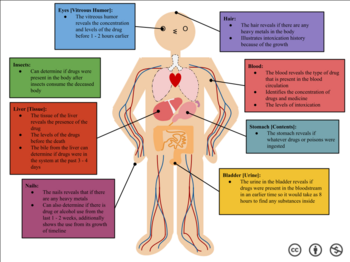
Back علم السموم الشرعي Arabic Съдебна токсикология Bulgarian Toxicologia forense Catalan Forensische Toxikologie German Toxicología forense Spanish Kohtukeemiaekspertiis Estonian سمشناسی قانونی Persian न्यायालयिक विष विज्ञान Hindi Toksikologi forensik ID Tossicologia forense Italian
Forensic toxicology is a multidisciplinary field that combines the principles of toxicology with expertise in disciplines such as analytical chemistry, pharmacology and clinical chemistry to aid medical or legal investigation of death, poisoning, and drug use.[1] The paramount focus for forensic toxicology is not the legal implications of the toxicological investigation or the methodologies employed, but rather the acquisition and accurate interpretation of results. Toxicological analyses can encompass a wide array of samples. In the course of an investigation, a forensic toxicologist must consider the context of an investigation, in particular any physical symptoms recorded, and any evidence collected at a crime scene that may narrow the search, such as pill bottles, powders, trace residue, and any available chemicals. Armed with this contextual information and samples to examine, the forensic toxicologist is tasked with identifying the specific toxic substances[2] present, quantifying their concentrations, and assessing their likely impact on the individual involved.[3]
In the United States, forensic toxicology compromises three distinct disciplines: Postmortem toxicology, Human Performance toxicology, and Forensic Drug Testing (FDT).[4] Postmortem toxicology involves analyzing biological specimens obtained during an autopsy to identify the impact of drugs, alcohol, and poisons. A broad array of biological specimens, including blood, urine, gastric contents, oral fluids, hair, and tissues, may undergo analysis. Forensic toxicologists collaborate with pathologists, medical examiners, and coroners to ascertain the cause and manner of death. Human Performance toxicology examines the dose-response relationship between drugs present in the body and their effects. This field plays a pivotal role in shaping and implementing laws related to activities such as driving under the influence of alcohol or drugs. Lastly, Forensic Drug Testing (FDT) pertains to detecting drug use in contexts such as the workplace, sport doping, drug-related probation, and screenings for new job applicants.[3]
Identifying the ingested substance ingested is frequently challenging due to the body's natural processes (as outlined in ADME). It is uncommon for a chemical to persist in its original form once inside the body. For instance, heroin rapidly undergoes metabolism, ultimately converting to morphine. Consequently, a thorough examination of factors such as injection marks and chemical purity becomes imperative for an accurate diagnosis.[5] Additionally, the substance might undergo dilution as it disperses throughout the body. Unlike a regulated dose of a drug, which may contain grams or milligrams of the active constituent, an individual sample under investigation may only consist of micrograms or nanograms.

- ^ Gavanji S, Bakhtari A, Famurewa AC, Othman EM (January 2023). "Cytotoxic Activity of Herbal Medicines as Assessed in Vitro: A Review". Chemistry & Biodiversity. 20 (2): 3–27. doi:10.1002/cbdv.202201098. PMID 36595710. S2CID 255473013.
- ^ "Chemical Hazards and Toxic Substances". U.S. Dept. of Labor, Occupational Health and Safety Administration. Retrieved 5 March 2022.
- ^ a b Adatsi, F.K. (2014). "Forensic Toxicology". Encyclopedia of Toxicology. pp. 647–652. doi:10.1016/b978-0-12-386454-3.00387-0. ISBN 9780123864550.
- ^ Wagner, Jarrad R. (2020). "Introduction to forensic toxicology". An Introduction to Interdisciplinary Toxicology. pp. 445–459. doi:10.1016/b978-0-12-813602-7.00032-6. ISBN 9780128136027. S2CID 213092492.
- ^ Volkow, Nora D. "Heroin" (PDF). National Institute on Drug Abuse. Retrieved 5 March 2022.
© MMXXIII Rich X Search. We shall prevail. All rights reserved. Rich X Search